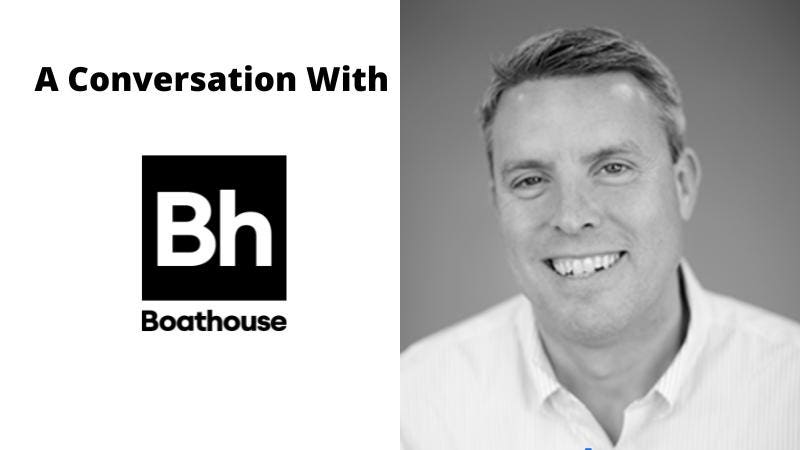As 2023 unfolds, AI continues to be the bright shiny object that everyone is buzzing about, yet few really know what it is beyond a surface level. There is even wide spread discussion of how ChatGPT will suddenly make humans obsolete in every industry from technology to journalism. However, what too many people are overlooking is the slippery slope that exists when AI is used in isolation without any type of ongoing direct human input. As all organizations continue to struggle to acquire and retain customers, being as human led in their approach to operationalizing AI as possible will be critical.
For my latest column, I wanted to speak to someone agency side who is at the forefront of leveraging AI in ways that enhance human intelligence, not replace it. With notable stints at iconic agencies such as Hill Holiday and McCann World Group, John Connors, currently Founder and CEO of Boathouse, is an industry visionary helping to imagine how the best of humanity and technology will enable the world’s leading marketers to best future proof their brands. Following is a recap of our conversation:
Billee Howard: Tell me about the vision of Boathouse and why you think old brand infrastructure is broken?
John Connors: We believe that the traditional brand management model is no longer viable. It is like an old car with too many miles that you simply can’t trust to get you to your destination. And yet, marketers have a fondness, a nostalgia that makes them unable to abandon the old rust bucket.
When the idea of brand management was introduced in a three-page memo by Neil H. McElroy at P&G in 1931, it was visionary. Mr. McElroy ran advertising for Camay soap, and he needed to differentiate Camay from Ivory. The solution matched the problem and brand management proved an exceptional model for almost 100 years.
But today, the problems companies face have changed, the scope has changed and the speed has changed. Leadership teams must manage across multiple stakeholders ranging from employees to investors, media, consumers, regulators and community. They also have to contend with multiple issues that cut across the spheres of the economy, politics, the environment and business, in a marketplace where brand and reputation are converging. Yet interestingly, many marketers still seek inspiration from the increasingly dated brand management playbook.
Our goal is to help the CMO find new models and new tools to be successful. We work for the CMO, we live and die based on their credibility. We need to help them be successful. We can’t let them drive a 1931 antique into the board room.
Howard: You mentioned you view AI as a horizontal game change. Tell me more.
Connors: As you know, marketing has reinvented itself numerous times since brand management was introduced in 1931. Marketing has evolved as the dominant channels dictated. Throughout these cycles of change, marketing departments have continued to add on to their org charts, building new departments to manage new channels. Today, most marketing org charts have some combination of brand, digital, social, analytics and communication specialties. Each specialty has a team, a budget and an agency partner and the unintended consequence is that we have created silos that, along with antiquated strategy models, are creating drag on speed and performance.
Now you add A.I. to the mix – the latest market shift – and it gets interesting. A.I. does not respect silos. A.I. wants to work across brand, acquisition, news, digital, social and data. We are starting to face a new “manager vs. machine” battle. A.I. will challenge the control and the sprawl. CMOs will be forced to deconstruct their org charts to drive performance. But it is not just the org charts that will be challenged. A.I. will also challenge the brand management model and will force marketers to look for new strategic frameworks that are built for this era. A.I can handle multiple stakeholders, multiple issues, constant change and speed. Marketing departments, as currently constructed, cannot.
Howard: We spoke about the economics of narrative. Can you share more and why this is such an important emerging way to look at brand?
Connors: In our search for new, more relevant models we started inside the marketing thought leadership circles. Unfortunately, there are simply not many new strategic models in marketing. Today a search of “marketing thought leaders” reveals a collection of CEO stories, media personalities and academics riffing about brand management. The leading marketing thinking of today seems more focused on selling books and building followers more than truly original models.
This led us to search outside of marketing. In our research, we uncovered a model called Narrative Economics from Nobel Prize winner Robert Shiller. His premise was simple – narratives drive economic impact. Shiller’s case was based on the data that emerged when Google indexed every book and newspaper in history. By combining historical and economic data, Shiller was able to go back in time and highlight the relationship between market narratives and economic cycles. We believe Narrative Economics in combination with more sophisticated A.I.-driven tools is the beginning of a new strategic foundation for modern brand management.
Howard: You are building a next Gen AI stack designed to do many things…treating reach as a variable and exponential growth driver is something you mentioned when we first spoke and it’s quite intriguing. Can you share more?
Connors: As we progressed in our thinking, we started to focus on how we leverage A.I. and narrative into a clear benefit for our clients. We started to align our tech investments, our strategy and our delivery on a simple and bold goal: increase client reach 10x over three years. The reality is that most CMOs are given irrational goals and no additional money to achieve those goals. In practice CMOs then sprinkle the dollars equally across all their silos and little changes. We aimed to upend that cycle of failure.
To help make 10x a reality, we are building an “A.I. Stack” out of best of breed technologies for strategy, media, creative and analytics. Like the MarTech stacks of the last decade, this collection of technologies allows us to mix and match best in category solutions. By connecting the A.I. stack. + narrative framework we can seek out relevancy, insert ourselves into the conversation and expand our client reach and impact. We have a relentless focus on what performs rather than what is sexy. We use AI in the places where it will help us to help our clients to out-think, out-execute and outperform the competition. Everything we do is centered on our goal of helping the CMO find new models and new tools to be successful.
Read the full article here




